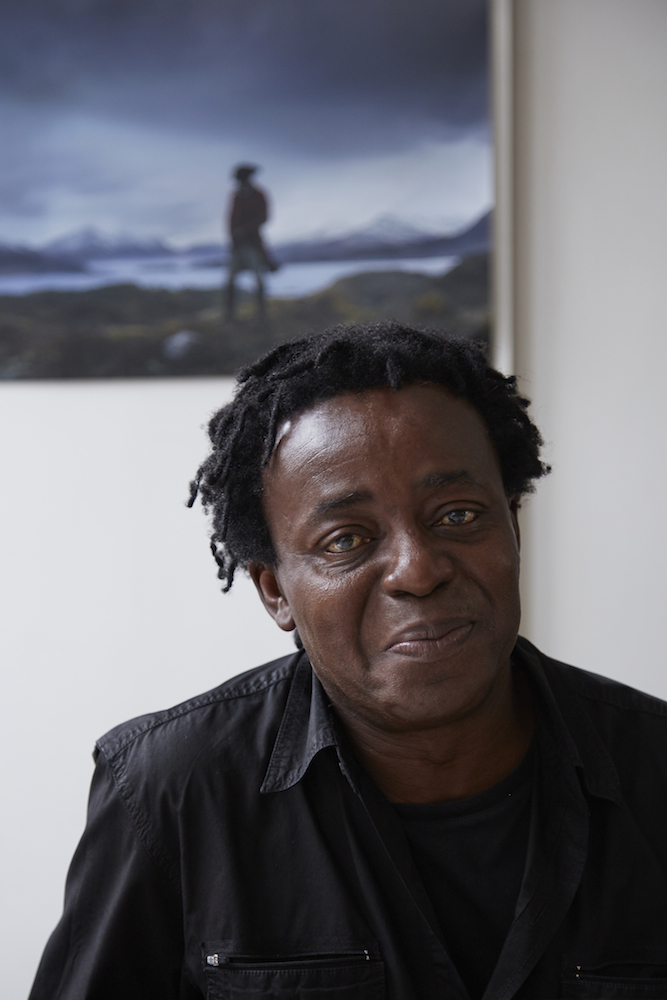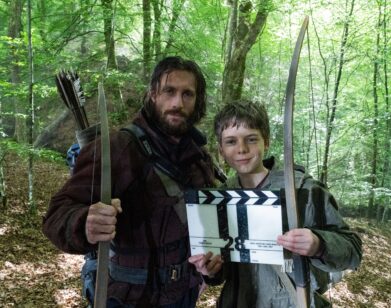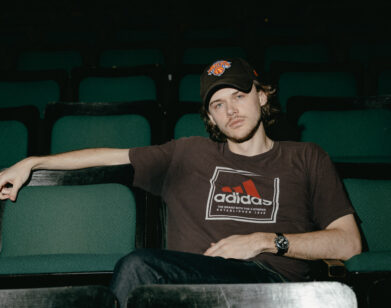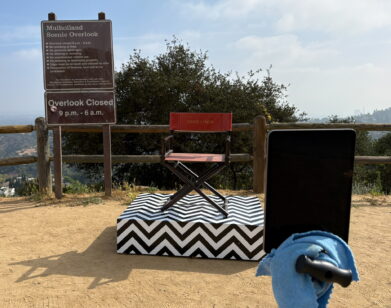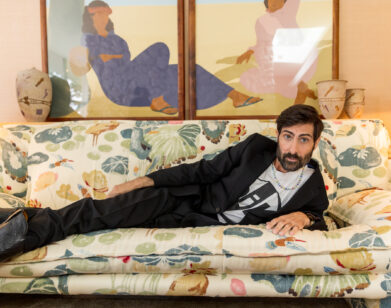John Akomfrah and the Image as Intervention
Images and their authors construct our collective memory. What we’ve seen, often, is what we believe we know. That supposed knowledge is a subject that British filmmaker John Akomfrah, OBE, is acutely aware of. Since his time at university in the early ’80s, when he formed the Black Audio Film Collective with fellow students at Portsmouth Polytechnic, he’s been steeped in the archival. Images have been his tool for historical intervention, their recontextualization taking form as a subversive act and challenging repeated inadequacies and inaccuracies of representation.
“It’s as if there’s now an intangible bank of images that most people carry,” Akomfrah says when we sit down in New York. “The cinema has colonized our unconscious. It’s difficult to not see through the ghostly presence of those who’ve had a major say in how you’ve lived your life with the image. We don’t go naked into the conference chamber of making images without that chip [of archival images] inserted somewhere in our cerebral cortex,” he continues. “The archive has migrated from my shelves imperceptibly into my head, I suspect into all of ours.”
As of late, Akomfrah’s work consists entirely of original footage, which is a shift from his previous works, such as his montage documentary The Stuart Hall Project. He remains consistent in his use of visual allusions, though, cracking open fissures in history to fill with images anew. Last Friday, two of these recent, multi-channel film works—Auto Da Fé (2016) and The Airport (2016)—arrived stateside at Lisson Gallery, marking Akomfrah’s first major solo show in the U.S., simply titled “John Akomfrah.” Both works are haunting historical meditations, with Auto Da Fé achingly addressing the history of the migrant experience and The Airport delving into Greece and its debt crisis. While they’re poetic and certainly surreal, their efficacy hinges upon the realities they echo. They are accompanied by a set of photographs in which the characters from the films, including an astronaut, reappear, seeming all the more still in their moving counterpart’s presence.
HALEY WEISS: I know that migration has been a huge theme in your work. I’ve been thinking about the current refugee crisis, how it’s being characterized, and how you said that there’s amnesia about migrant crises over time. How do you see the current migrant crisis fitting into the history of the migrant experience?
JOHN AKOMFRAH: It fits in two ways, but what’s important for me at the moment is to try and find a narrative through which the current crisis makes cultural and emotional sense. What I’m very keen to do is to provide people with a narrative setting in which the current crisis—far from being an aberration—segues into a five-century history of movements that have been somehow engineered by crises. I then begin to suggest that this [current crisis] has a flavor of necessity and legitimacy about it. When you think about our understanding of the “New World”—the Americas for instance—yes, of course, there’s the conquistador myth and narrative, which is about people voluntarily coming over, but actually quite a lot of people in this part of the world are here because of some kind of crisis involuntarily. They could be Pilgrims, Sephardic merchants from the Iberian Peninsula, or Huguenot persecuted minorities in Northern France; there is a whole range of people who made large sections of the “New World” possible because multiple crises in the space in which they would have probably happily stayed made it impossible for them. When Queen Isabella of Spain declared in 1492 that all Moors and Jews should leave, you had to go.
This is a near five-century history. What that means to me is that there is an affinity between what’s going on now and other forms, other moments, other events which were engineered by crises to the point where you can see that far from this being like an accident, it’s almost a norm, a feature of our modernity. There are moments when difference is not acceptable in a certain space and migration is the only possibility, either forced or voluntary. That’s really what I’m concerned with at the moment, to rescue the legitimacy of the Yazidi, Afghani, Syrian, and Palestinian migrations that have been force-fed a certain kind of “radiophonics of emergency” by the space that they’re in. There’s an announcement that says, “You die or you leave,” and that’s a fairly compelling argument for flight.
WEISS: Your parents lived in Ghana when it was under British colonial rule and known as the Gold Coast, and were involved in the independence movement in the ’50s. I wonder how their experience of being under colonial rule, and your family moving to England when you were four years old, has informed your understanding of colonialism.
AKOMFRAH: The interesting thing is that both of my parents lived in one of those seismic shifts that happened to very many parts of the world, three quarters of the world in fact, between ’44 and ’64. Large sections went through these convulsions where their identities changed radically. The Gold Coast is one of the first because that transformation happened in ’57, the year I was born, which means that for the generation before me, my parents, they knew an old world and a new one. I lived in Ghana at a time when there was only the new, when the promise of the new was still bright and shiny. But I think pretty quickly it became clear that there were certain “radiophonics of emergency,” as I call it, in the air—military coups, assassinations. We were about to enter the postcolonial. In a way, my parents knew three conceptual leaps—understandings of the afro-space—and I lived two. Well, now a third, because in a way there’s a swing back to something else.
That emergency is very similar to one that people leaving, let’s say Syria now, will understand. I certainly understand. I was very young but I still remember that moment when I thought, “Okay, this is not safe.” Something in the air just tells you, “You might not be okay for much longer.” I felt it as a kid so you can imagine what the grown-ups in my family felt; it was very palpable, it was tangible, the sense that your time was up. A line had been drawn that if you lived beyond that, you were then going to be in a space of peril. I think that’s what emergency means for most people in these moments of great upheaval. You’re aware that there’s a line that you’re about to cross and once you cross that line, by staying, all the guarantees that underscore your previous security, comfort, certainty, etcetera, are about to be either erased or function under erasure. I think part of the capacity, the cognitive faculty that we have as humans—one [reason] why we’ve survived for so long—is our grasp of that sixth sense, the knowing of the really intangible signposts. You feel when you’re not safe, when flight is the only option.
I’m trying to join my own understandings and feelings about this with what is going on now. If you’re a conservative with a capital “C” pundit or political figure in England, it’s very easy, in fact cheap, to call people who are under the spell of the emergency “rats” because you’ve never lived it. But when you have, like me at a much earlier age, it seems that there’s a certain ethical compunction to say otherwise, to begin to construct a counter-narrative by which lives that have been plunged into a kind of pre-human or post-human space can be rescued and made sense of again as human accounts, as narratives. That’s what you lose. [There’s] a danger of becoming a statistic in a war of anxiety, especially in Europe, where one feels this sense that we’re about to be overwhelmed by something unknown, “rats.” It’s actually not fucking true. We’re not about to be overwhelmed, but every time that moral panic is raised, the consequence of that is to render someone’s life or a chapter of the lives of people from another region of the world meaningless. It’s as if they only exist to be contagion. I’m very keen for the utopian dimensions of new migrant lives to make sense and by utopian I simply mean a sense people have that there might be a future, and that that future could be better than the one they’re living at present. It doesn’t take very much to have that utopian feeling when you’re living in a war-torn space. Anything is utopian compared to the dystopian space that you’re in. People get on these boats or rafts because they want their lives to have a future. How you translate all of that into [film] is something else, but those are some of the emotional, intellectual ambitions behind the work.
WEISS: You received a lot of criticism in the ’70s and ’80s because your films weren’t cinéma vérité. It seems so odd that your work was perceived as fictitious just because it was constructed, because even vérité is constructed.
AKOMFRAH: A lot of the conversations in which those criticisms appeared were really productive because they helped you refine what it was that you were about. Half of the time when you start something it’s not exactly clear to you what you’re doing. You feel a certain compulsion to do it but you’re not sure intellectually why you’re doing it. Now, looking back, it seems to me that three things were going on. One was that people like myself had a certain kind of impatience with what had been the normative procedures for engaged practice, militant practice, and political practice. [We] felt that the things that we had inherited were becoming a stereotype of themselves and that it was in need of renewal. We were very clear that it was always a generational necessity for reforming it. The second thing was this certainty of what I would call the ethnographic approach, which was reaching a certain kind of end. There were anthropological procedures that in documentary filmmaking said, “There is a truth out there and the only job that we need to do as filmmakers is to point the camera at it and it will reveal itself.” Something about it just didn’t feel true. The final thing was even more nebulous but also present at the time, which was it felt to my colleagues and me as if a certain post-war contract between image-making and “the real” was coming to an end. It felt as if the horrors of the Second World War had guaranteed a certain way of working, a fidelity to what was available, because suddenly we were aware that we didn’t know the full scope, range, reach, and darkness of the human heart, and that we needed to get back to basics.
That contract, which image-making had entered into, was coming to an end because we were about to undergo something else where in fact that idea was going to be manipulated by conglomerates and corporations, [saying things] like, “It’s really real,” “Just do it,” and, “Get out there and be yourself”—all of that shit. [laughs] I think all three regimes were converging at the same time. It was very difficult when you were in it to see that this was going on, that in fact we weren’t raging against one machine but a number of overlapping narratives, which were creating these machines. Now I’m very comfortable with it but at the time it was worrying. You thought, “Am I really a pariah?” We weren’t entirely comfortable with that position but something felt worth exploring.
WEISS: What medium are you most interested in working with now? Also, when you have a film in a gallery setting, people will walk in and out when they want. Is that lack of control something you take into account?
AKOMFRAH: Absolutely—one of the things, which I’ve started to enjoy, is the way in which the more discrete pieces seem to chime with a tape that I think has been there all along. Take the [Black Audio Film Collective], one of the dreams behind it was to make something that was inherently democratic, for all people, [where] people could see their own world, or make images themselves, etcetera. The minute you get into more discrete pieces you become aware that there’s a manifesto of some of these democratic precepts; people engage with it how they want, they come in, watch what they want, and leave, and that has to be part of the offer because otherwise, make cinema. [laughs]
I’m still interested in cinema, I go in and out of it, and I will still probably make one or two more things specifically for television. Both have certain narrative requirements [and] occasionally I think of something that fits those requirements. For instance, if you wanted to do a commemorative piece as I did on the March on Washington in 2013, [titled The March and narrated by Denzel Washington,] there’s no better space than television. There you say, “I want to listen to a range of people bearing witness.” That has a certain economic [value] that can’t be met in a gallery setting or a more discrete setting. And then there’s television’s sense of a collective address, which is also necessary for that… That’s why I do it, not for me as an artist, but for an audience. With cinema, there are certain narrative demands that are best met when a group of people for a moment in time can say to each other, “We will forgo something called an individual take for this collective experience,” in which we will all agree to a minimum set of rules: we’re not going to talk, we’ll sit alone in the dark, but we will be together and somehow, the experience of this moment will be enhanced by the fact that we’re a collective. Those are not by any means possibilities that explore all of the available range of image experiences. Now, the desire is to see how many more spaces you can work them into because it’s necessary, it feels right, it feels timely, and there’s no reason why we shouldn’t.
WEISS: You’ve spoken about the significance of the archive as a space for intervention. What do you find most vital about intervening in history through the use of archival material?
AKOMFRAH: That is a big question. [laughs] It seems to me that there’s something about the existence of footage that suggests that from its inception, it had a role, a purpose, a destiny, and one of those was that it should be seen. The intentions of those who gathered it, organized it, cut it into whatever tale, story, or news report it was, are not always clear. Sometimes it’s clear, they simply wanted to say, “That group of people are a problem.” The archive, especially the moving image archive, comes to us with a set of Janus-faced possibilities. It says, “I existed at one point and it’s possible that I could exist differently.” But in order to find that you need something else, which is not in the archive, which is the philosophy of montage. Montage allows the possibility of reengagement, of the return to the image with renewed purpose, a different ambition. So I’m interested in the archive firstly because of that possibility of return but I’m also interested in its indexical time; it feels always as if it is in some ways a fragile, contingent deposit of lost time, of a moment, and I like working with those Proustian possibilities. But I also like it because if you come from a space, community, or group that isn’t represented by all forms, by monuments, one cannot discount the possibility of the archive as a repository of memory. Precisely because one can’t discount it, it is always worth investigating.
“JOHN AKOMFRAH” WILL BE ON VIEW AT LISSON GALLERY UNTIL AUGUST 12, 2016.

